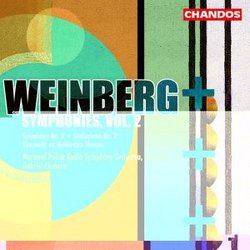| All Artists: Mieczyslaw Weinberg, Gabriel Chmura, The National Polish Symphony Orchestra in Katowice Title: Weinberg: Symphony 4 Op. 61 / Rhapsody on Moldavian Themes Members Wishing: 0 Total Copies: 0 Label: Chandos Release Date: 9/21/2004 Genres: Special Interest, Classical Style: Symphonies Number of Discs: 1 SwapaCD Credits: 1 UPC: 095115123720 |
Search - Mieczyslaw Weinberg, Gabriel Chmura, The National Polish Symphony Orchestra in Katowice :: Weinberg: Symphony 4 Op. 61 / Rhapsody on Moldavian Themes
CD Details |
CD ReviewsA varied and interesting program of Weinberg's works Russ | Richmond, VA | 07/15/2006 (5 out of 5 stars) "It is likely that the majority of classical music fans are unfamiliar with the music of Mieczyslaw Weinberg (1919-1996); some however may have seen his name appear in writings mentioning that he was a close friend of Shostakovich. Weinberg was born in Poland, but moved to the Soviet Union upon the Nazi occupation of Poland in 1939. It should be noted that "Weinberg" is the Polish spelling of the composer's name, while "Vainberg" is a Russian spelling and appears on some previously released CD's on Olympia and Naxos.
Weinberg's life wasn't easy. His parents and sister were murdered by the Nazis and Weinberg was heavily persecuted by the Soviet authorities. Weinberg himself was arrested by Soviet police in 1953 on the false charge of taking part in the preparations of creating a Jewish republic within the Soviet Union, although, Weinberg was released shortly after the death of Stalin. If the Symphony No. 4 is any indication, the 22 symphonies of Weinberg really must be one of the outstanding musical achievements of the twentieth century. This is a fantastic and vibrant work. The open section of the symphony definitely shows the influence of Shostakovich with its aggressive cello and double bass writing, followed by clarinets (playing above their natural range) jumping out of the orchestral texture. At the conclusion of this movement, Weinberg's unique sense of drama becomes apparent, where the music gradually builds to an intense frenzy; then ends quite unexpectedly. I find the third movement, characterized by a melancholy melody played by solo woodwinds over pizzicato strings, to be quite beautiful. The work is capped by an inventive finale in which Weinberg combines Polish and Russian dance melodies in a rondo format. The exciting conclusion of this movement won't leave you disappointed. The Rhapsody on Moldavian Themes, or at least the second half of it, is really an orchestral showpiece with its colorful orchestration and blazingly fast string playing. It has been suggested that title of this work was meant to deceive the anti-Semite Soviet authorities, as the themes of the work actually are derived from Jewish culture. The seventeen minute Sinfonietta No. 2, scored for strings and timpani, is a far more somber composition. There are some similarities to Bartok and late Shostakovich within this work. The first movement is aggressive and rhythmically complicated, while the other three movements are relatively calm, but there is a certain sadness permeating this final movements. The final movement contains an aching waltz-like melody and concludes with a sparsely scored pianissimo coda. The varied selection of pieces included on this CD gives a good overview to Weinberg's style. I initially found the more extroverted Symphony and Rhapsody to be more attractive than the Sinfonietta. However, I warmed up to the Sinfonietta after a couple of listenings. My only reservation is that I wish Chandos chose to include one more (faster tempo) work to round out the program. Despite that, this is truly an important release of the works of a neglected composer, and is completely recommended for those who enjoy twentieth century symphonies, or the works of Shostakovich. I just hope that this series featuring the symphonies of Weinberg continues. Two down, twenty to go. 59:56" |


 Track Listings (9) - Disc #1
Track Listings (9) - Disc #1